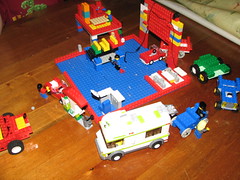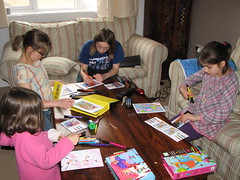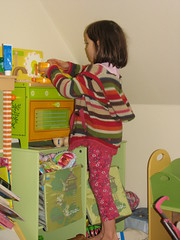Play seems to mean a multitude of different things. It means something a child does that keeps them out of their parents hair, something children do together, sometimes it means a game inside, or a game outside; to me, as a child, playing usually meant being alone, deeply engrossed in a game from my imagination that had no room for anyone else to be involved at all. I disappeared into worlds in those days, playing alone but entirely happily, for hours and days at a time. My stock of props was a small cardboard box filled with drawing pins, paper clips, plasticine, coins, a few chess sets and assorted other oddments that could be anything I wanted them to be.
I built worlds out of nothing. In my childhood, I had very few collections of branded toys; I liked My Little Pony, I loved Lego, I played with Strawberry Shortcake. Mostly though, I played with bits of nothing. Endlessly.
So what about learning? I’m a home educator and I also sell toys for a living. I’m a person who believes completely in the innate ability of children to explore things that interest them and find out what they need through a personal and driven desire to understand the world around them and I believe children will do that without reward from an outside force, if they are allowed to develop a belief that understanding is a reward in itself. I believe, really, in using the world to learn and play, though I do of course believe in toys too!
When I had children I was initially startled to discover that not all of them were going to be like me; Fran really could not play in that way, she needed to be entertained; she made mess, not games. Maddy on the other hand would find two things of a similar style or colour and then play a game with them, but always the same game. She would mimic a scene from the film A Bug’s Life with whatever came to hand. It was Amelie who taught them to play, bringing her natural talent for leadership and inventive imaginative play to the forefront of their free time and suddenly the world of “things” became real to the other two, who had previously played beautifully together in make believe worlds but always as actors, never with toys. Finally Josie appeared and there in front of me unfolded the child I had been. Josie plays exactly as I did as a child.
As a parent and a toy seller it really bothers me that we have fallen into the limiting trap of assigning specific learning values to toys. I loath seeing “Meets Key Stage 2 Objectives” printed on to a game. I can’t help feeling that children deserve time to play in a real sense, instead of being endlessly pushed through hoops. The learning that comes from play is vital, but it should be incidental to the sheer joy of living that moment of childhood.
By the time most of the “play based learning objectives” started to hit nursery school environments, it was Amelie who was going and I was able to snort derisively at the person who called me in to say that Amelie was still in a circular play schema after 2 months and therefore needed x corrective play procedure to move her on. I just wanted her to be doing painting where someone else cleared up the mess. I didn’t care if she was was painting circles. I didn’t really care if she was going round in circles!
I think I’ve got a pretty good handle on both learning and playing now. My definition of learning is not squirrelling way facts or learning to work through maths problems. My definition of learning is acquiring skills and a knowledge base of concepts that fits you for life, of developing passions and ideas and learning to learn. I encourage my children to examine and explore and consider and dissect and it seems to me those skills will fit them for anything. More often than not, the things the children happen to learn about, from volcanoes to healthy lunches, are a by product of skill acquisition, discovering how to find information, how to plan a project, how to present findings, how to work as a group and manage a situation.
When I look at all the things I consider to be the vital to the development of my children as they grow into adults, I realise and observe that they get just as much from playing as they do from any contrived learning experience. My children have very little concept of what is ‘work’ and what is ‘play’ and I try not to value one above the other in any great sense.

Their recent foray into Lego took almost 6 solid weeks of the year. They built, they researched old and new Lego on the internet, they planned buildings and developed scenarios, they negotiated piece sharing and they developed building skills. From simple squares came complex floor plans and pulley systems, from arguments over how a game altered came enhanced social skills and thoughtful team work. I had almost no input (aside from adding more Lego!) and yet the learning that went on during that time was enormous. It would have been a travesty to interrupt it and sit them in front of a workbook.

Today they’ve been colouring; to the unsympathetic eye this might not seem terribly educational or meaningful. You might not even think it was play unless you knew that they’d narrated a long and complicated story as they sat together, inventing a world in which they were all slaves being forced to colour against their will, adapting around each others ideas as they went. It might not seem meaningful unless you knew this was something Fran loves to do because she can do it well and it fills her with pride to finish something beautiful and know that effort brings reward. For Maddy is is an opportunity to do something stress free because it has boundaries and rules, for Amelie it is an exercise in patience and for Josie it is a great leveller, because she can be as good as her sisters. There is pen control and thinking and talking about the themes of the pictures, there are numbers on the pens for Josie to recognise and levels of difficulty and dexterity to negotiate.
They’ve learned and they’ve played today, though they probably don’t think they’ve done either. They think they’ve lived. And that, after all is what life is often about – playing and learning.
Written for the Tots100 March blog hop on Learning through Play.




Colouring has so much going for it. My nearly four year old having never had any interest in colouring and until a couple if weeks ago was scrawling black circles as his best efforts, has suddenly taken to lying in the floor for hours colouring as neatly as possible. Perhaps getting the spiderman / toy story pictures was the lever but he’s hooked. Now just needs to work out which is his dominant hand as still writing/drawing with both. Concentration, fine motor control, colour mixing &matching, determination to produce a good finished article etc etc all suddenly starting to come together and lovely to watch.
I loved this, Merry. Play is so undervalued in our society and it mystifies me. We have one who loves imaginary games – with others, alone, with toys, without. It is, I think, many children’s primary way of learning and can remain so for years longer than is allowed in schools. I don’t doubt that a lot of the writing of our play loving child comes out of play – plot lines developed around a toy castle, action scenes acted out with friends in the park and much, much more.
Ha. I love the fact that rather than being forced to learn against their will, they invented a game where they pretended they were doing it against their will. There’s probably some amazing lesson about human nature in there, but who cares, i started day dreaming as soon as volcanoes came up. Wooooooo, KABOOM!
Great post! My kids play imaginative games past the age I think their schooled peers do – my 10 & 12yo boys still play role-playing games and small-world play most days. My eldest (nearly 14yo boy) does too, but in a way that many adults do – he creates games (role-playing ones like D&D and board games) and he spends a lot of time playing with his youngest sibling.
I think learning through play in UK schools is very different to learning through play in Scandinavian schools and Steiner schools. Here, there seems to be a tendency to set up some toys, stand back and observe the children passively, whereas in traditional play-based schools, it seems that the adults play with the children more, sometimes directing and sometimes taking direction. I think that adults in the UK have lost some of their ability to play (or is it just me?!) and, particularly in schools, don’t spend much time interacting with children on their level.
I love that your girls had a story about why they were colouring. That’s just so brilliant – what is normally an individual activity was made into a group one by them.